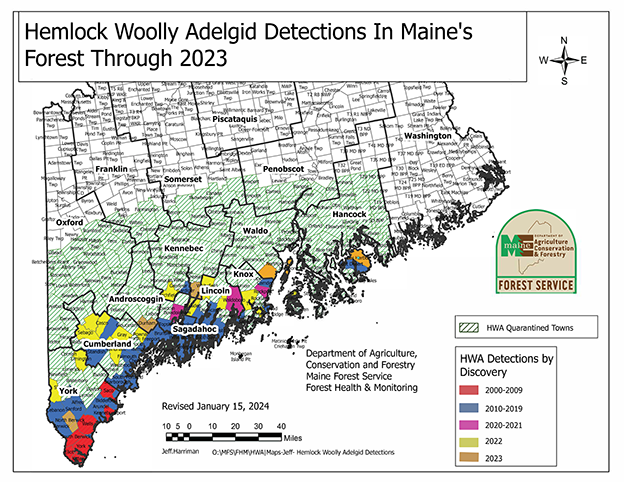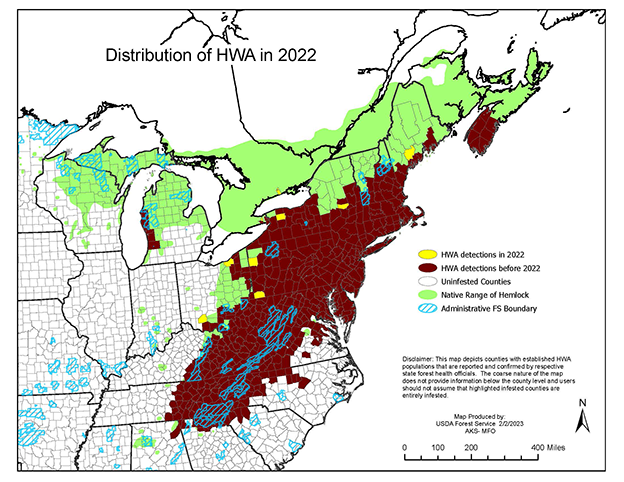DACF Home → Bureaus & Programs → Maine Forest Service → Forest Health & Monitoring → Forest Pest Index → Hemlock Woolly Adelgid → Hemlock Woolly Adelgid Overview
Hemlock Woolly Adelgid Overview
- On this page:
What is Hemlock Woolly Adelgid?
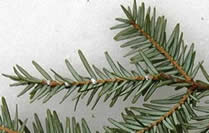 Hemlock Woolly Adelgid (Uh-dell-jid) (HWA) is an introduced, aphid-like insect from Asia that attacks eastern hemlock. As of 2021, twenty states and two Canadian provinces have detected HWA. Many areas infested with HWA display extensive tree decline and mortality. HWA affects all species of hemlock but does not affect pine, spruce, fir, or other conifers.
Hemlock Woolly Adelgid (Uh-dell-jid) (HWA) is an introduced, aphid-like insect from Asia that attacks eastern hemlock. As of 2021, twenty states and two Canadian provinces have detected HWA. Many areas infested with HWA display extensive tree decline and mortality. HWA affects all species of hemlock but does not affect pine, spruce, fir, or other conifers.
The most obvious sign of HWA is the covering of wool-like wax filaments produced as the insect matures. The woolly masses generally range from about 1/16-inch to 1/8-inch in diameter. They are most visible from late fall to early summer on the undersides of the outermost branch tips of hemlock trees.
As of 2022, hemlock woolly adelgid has been found in forests of over 60 southern and coastal Maine towns. Informed community members make most detections.
What Can You Do?
While there is little you can do to prevent the natural spread of this insect, you can help reduce the likelihood of hemlock woolly adelgid coming to your backyard and thriving in your trees. In our climate, there is usually time to “rescue” tree health on ornamental trees after detecting these insects. And, if forest trees are being monitored, there is usually time to plan a response before widespread damage from the insect.
- Do not move hemlock trees, seedlings, or nursery stock from infested areas (Maine Map).
- Monitor hemlocks regularly for signs of the insect. Community members make most detections.
- MFS Technician Wayne Searles provides a tutorial on searching for hemlock woolly adelgid in this quick video.
- Inspect newer growth for discrete white cotton ball-like masses on the undersides of the twigs, usually attached at the bases of needles and up to 1/8th" in diameter.
- You can monitor at any time, but December through February is an excellent time to look for adelgid because wool is visible, and you are unlikely to spread adelgid during your survey.
- Look at lots of branches (hundreds would be good).
- Cover the area that you are concerned about.
- MFS Technician Wayne Searles provides a tutorial on searching for hemlock woolly adelgid in this quick video.
- Hemlock woolly adelgid spread most readily from March through July, when eggs and crawlers may be present.
- Remove bird feeders when eggs and crawlers are present to reduce the number of birds drawn to your trees. Birds can transport HWA short and long distances. If you must feed birds, move feeders as far away from hemlocks as possible.
- Prune live hemlock twigs and branches along edges such as lawns and driveways to minimize their role in the spread of adelgid. Branches that touch vehicles visitors and equipment can spread or pick up adelgid eggs or crawlers. Consider removing hemlock branches near trails and resting spots where people can inadvertently spread the insect. Conduct this work from August through February to minimize the risk of spreading adelgid. At other times of the year, leave pruned branches on the ground.
- Conduct management activities in hemlocks such as harvest and cruising during August through February when eggs and crawlers are not present. For more information on forest management planning for hemlock woolly adelgid, see Silvicultural Options For Managing Hemlock Forests Threatened by Hemlock Woolly Adelgid (Orwig and Kittredge (PDF | 1.27 MB)).
- If you think you have found hemlock woolly adelgid outside of known infested areas, please let us know. If you have found it within known infested areas, you can find
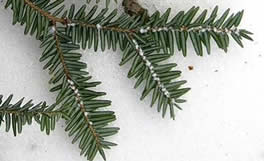 Look for These Signs on Hemlocks:
Look for These Signs on Hemlocks:
- Immobile, white woolly masses at the base of needles on the undersides of hemlock twigs
- Trees impacted for years will also display off-color needles, often with a grayish-cast, thinning crowns, and premature needle loss.
- Note: In Maine, this insect does not damage trees other than hemlocks.
- How do I know if I have a hemlock?
If you think you have seen a hemlock tree with adelgid in a new area, note its location and use our online reporting form or call the Maine Forest Service at (207) 287-2431 to let us know.
Don't be Fooled by These Imposters--They are not Hemlock Woolly Adelgid
Many things look like hemlock woolly adelgid at first glance. On closer inspection, they can be ruled out either because of their texture, their location or another characteristic. Remember, HWA will usually be found on the undersides of twigs at the bases of needles and is coated with a waxy material. When in doubt, please contact us.

Elongate hemlock scale can also be mistaken for hemlock woolly adelgid and is often found on hemlock trees already infected with HWA. Please let us know if you think you have found elongate hemlock scale.
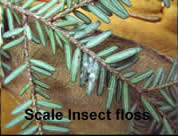
The Maine HWA Situation
Hemlock woolly adelgid is widespread along the southern coast; it is more scattered in towns as you move inland and eastward. Elongate hemlock scale is known to be widespread in the forests of southern Kittery. It has been found on planted trees in other areas of the state, and in several cases, is known to have spread to the surrounding forest. When scale and adelgid are found together, they will hasten the decline of hemlock. If you suspect you have found elongate hemlock scale, please get in touch with us.
As of December 2024, HWA is known to be established, in at least scattered areas, in the following Maine townships:
- Androscoggin County: Durham
- Cumberland County: Brunswick, Cape Elizabeth, Casco, Cumberland, Falmouth, Freeport, Frye Island, Gray, Great Diamond Island (part of Portland), Harpswell, Naples, Portland, Pownal, Raymond, Scarborough, Sebago, South Portland, Standish, Windham, Yarmouth
- Hancock: Mount Desert, Bar Harbor
- Kennebec County: Gardiner, Litchfield, Pittston
- Knox County: Camden, Friendship, North Haven, Owls Head, Rockport, South Thomaston
- Lincoln County: Boothbay, Boothbay Harbor, Bristol, Dresden, Edgecomb, Newcastle, Nobleboro, South Bristol, Waldoboro, Westport Island, Whitefield, Wiscasset
- Sagadahoc County: Arrowsic, Bath, Bowdoinham, Georgetown, Phippsburg, Topsham, West Bath, Woolwich
- Waldo: Isleboro, Liberty, Lincolnville
- York County:Acton, Alfred, Arundel, Berwick, Biddeford, Eliot, Kennebunk, Kennebunkport, Kittery, Lebanon, Limington, North Berwick, Ogunquit, Old Orchard Beach, Parsonsfield, Saco, Sanford, South Berwick, Wells, York
We suspect HWA is established in other townships in this general climatic region. Recent mild winters have allowed populations to build enough to reach detectable levels in areas where they had previously been established but at sub-detectable levels.
Maine's hemlock woolly adelgid quarantine area includes (map (PDF | 3.07 MB)) all of Androscoggin, Cumberland, Kennebec, Knox, Lincoln, Sagadahoc, Waldo and York Counties and parts of Hancock, Oxford, Penobscot and Somerset counties.
Counties in the Northeastern United States under quarantine for hemlock woolly adelgid shaded in brown and yellow.
Slow-The-Spread program for Hemlock Woolly Adelgid
Maine has developed an integrated pest management approach to hemlock woolly adelgid in the state called the Slow-The-Spread program for Hemlock Woolly Adelgid. It is based on four principles: Exclusion, Eradication, Containment, and Mitigation.

Management Tools in this approach include quarantines, surveys and monitoring, insecticides, biological control, and outreach.
External (between states) and internal (within Maine) quarantines regulate the movement of hemlock materials to reduce unintentional movement of HWA.
Maine Forest Service personnel regularly survey to locate new infestations and monitor the spread of HWA. Impact assessment plots have been established at six sites in Maine. Data from these sites will add to the understanding of forest impacts of the adelgid(impact plot summary (PDF)).
In the spring and summer, HWA can drop onto humans and vehicles and may be moved into uninfested areas. Using insecticides to treat infested trees in high-traffic areas can reduce the accidental human spread of HWA. Pruning branches overhanging high-traffic areas can also reduce accidental spread.
Biological control agents used in Maine include three species of predatory beetles. Laricobius nigrinus and L. osakensis are predators that feed on the winter (sistens) generation. Current research suggests that these species alone may not provide complete control as HWA populations can rebound in the spring (progrediens) generation. Sasajiscymnus tsugae feeds on both generations and is the only species that landowners can purchase. Release sites are monitored periodically for beetle establishment (monitoring protocol (PDF)) and all three species have been recovered at multiple sites. Impact assessment plots have been established at two release sites. Biological control is the best hope for long-term control of HWA in Maine’s forests. However, it may take many years for predator populations to rise to levels that will provide control. Therefore, an integrated approach using targeted application of pesticides to certain trees may allow trees to remain alive and healthy until the predators can provide control. (HWA IPM Manager Guide (usda.gov) (PDF | 8.26 MB))
An informed public plays an essential role in detecting HWA. Publications such as the Conditions Reports help enlist public support and educate community members in HWA detection. Maine Forest Service also cooperates with Ecosystem Investigation Network to engage students in monitoring for the pest (see their HWA Field Mission).
Additional Resources
- Overview of Hemlock Woolly Adelgid Life Cycle
- How to Identify Hemlock: A quick key for identifying hemlock
- Management Information
- Hemlock Woolly Adelgid Fact Sheet
- December 2022 Webinar: Hemlock Woolly Adelgid IPM in Maine
- Managing Hemlock in Northern New England Forests Threatened by Hemlock Woolly Adelgid and Elongate Hemlock Scale (PDF | 13 MB)
- Silvicultural Guidelines for Management (PDF | 1.27 MB)
- Information on the quarantine on hemlock in Maine
- Additional background information on the hemlock woolly adelgid
- Posters
- Volunteer: Look for Hemlock Woolly Adelgid and Report What You Find
